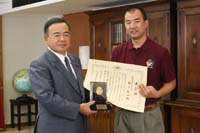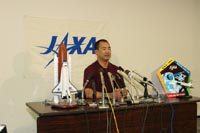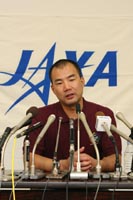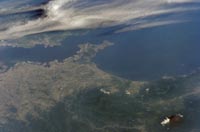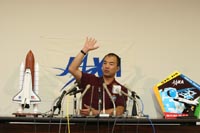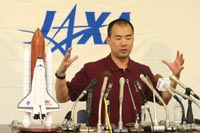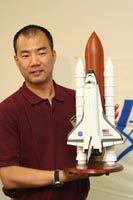|
|
Sitemap | Contact us |
|
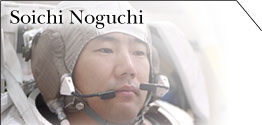 |
 |
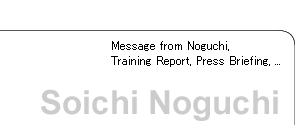 |
|
|
Press Conference (2005.9.28)On September 28, 2005, Astronaut Noguchi made a courtesy visit to Minister Nariaki Nakayama of the Ministry of Education, Culture, Sports, Science and Technology.
Minister Nakayama awarded Astronaut Noguchi with a Special Award for Science and Technology for his role during the Space Shuttle Discovery mission, during which he became the first Japanese to serve in a leading EVA role, led many successful activities, and created an awareness among many Japanese of the great scientific and technological opportunities that exist. Afterwards, a press conference was held in the press conference room of the Ministry of Education, Culture, Sports, Science and Technology. The conference opened with a brief greeting and introduction by Astronaut Noguchi.
Noguchi:Hello.I am Soichi Noguchi from JAXA.STS-114, the Space Shuttle Discovery mission, was successfully completed thanks to all of your support.It was a fifteen-day trip, but I managed to complete 100% of what I had done in training and accomplished everything that I could have done.The flight ended two months ago, but the beauty of Earth and the magnificent images of the ISS are still fresh in my mind. During this visit to Japan, I wish to show my gratitude to the children and Japanese people who supported me all this time and to pay tribute to those people who had taken care of me.Due to the hurricane, my six fellow American crewmembers' arrival is delayed, but arrangements have been made for them to arrive later on this week.Once the entire crew is together, I believe there will be another opportunity to meet with you. The assembly of the International Space Station will continue in the future.As previously announced, a new initiative in the development and construction of a new generation of spaceship has started in the United States.All of the JAXA astronauts and the entire JAXA organization will work together for the advancement of manned space flight.I, myself, am willing to make any contribution, including the support of other astronauts, towards the advancement of manned space flight. 【Question and Answer session with the media】 Highlights of the question and answer session are as follows.
Q. This is your first time back in Japan after STS-114.What message do you wish to convey to your fellow Japanese citizens? A. From my perspective, the people are interested in how I felt, the beauty of space, and what the International Space Station (ISS) was like, so I would like to tell them of my actual experience in my own words. Q. What is it like coming back to Japan from space? A. This is my first time back in Japan in a year and two months, and quite frankly, I am relieved to be back.Each day after I returned to Japan, I realized there are so many people who are supporting me.I’m humbled by this, and I am very grateful for their priceless support. Q. What is your goal in the future? A. First, I would like to convey my experiences and lessons learned from this flight to the other Japanese astronauts and to the space agencies, including JAXA and NASA.Then, we, the astronauts, would like to support the Japanese Experiment Module’s "Kibo" launch mission, which is getting closer. There is a possibility for me to receive Expedition Crew training or to receive training in Russia in order to secure my next flight opportunity.I would like to set this as a new goal and to start striving towards it. Q. Currently, many children wish to be an astronaut or to be just like you.What do you think they should do in order to make their dreams come true? A. I am pleased to see that the young children were eagerly watching this mission and that it helped to foster their dreams of space, including the work of the astronauts.If you maintain a firm grasp on what you want to do and keep moving towards it, then one day you will finally achieve it.Sometimes it takes a long time and it may come true in unexpected ways.So, look straight into your dreams and strive for them. Q. What were the results of the tile repair demonstration that was tested during the EVA?Tell us of the results, to the extent that you are familiar with them. A. Repair demonstrations of the TPS tiles and RCC panels were conducted during the first EVA.Currently, NASA is conducting wind tunnel tests on those samples to see if the repair samples would have survived the heat during reentry.NASA will use a type of wind tunnel known as an arcjet to test whether the samples survive in heat of around 3000 degrees F and if the samples do in fact survive, to then investigate in detail what the surface conditions would be like. Q. The "Eboshi-iwa Illumination Project" has taken place off the coast of Chigasaki.Were you able to see Eboshi-iwa from space?
A. I am sincerely grateful for the passionate support from the citizens of Chigasaki.I could not see Eboshi-iwa because it was nighttime and on the night the Eboshi-iwa was illuminated, it was not viewable due to poor weather.However, I passed over Kanagawa many times during the noon timeframe, and I did my best to take pictures of the area. Once I was back on the ground and closely examined the photos, I found Eboshi-iwa.I stated that I was going to watch the rock with eyes in my mind, but now I've brought back proof that the Eboshi-iwa is visible from space.I will show this proof to the people of Chigasaki during the debriefing. In regards to what I would like to do when I go back to Chigasaki, my six fellow crewmembers will visit Chigasaki with me, so I would like to show them my hometown.I gave them name patches with the Eboshi-iwa design embroidered on it and everyone liked it.So, I would like them to see the real Eboshi-iwa from the shore. Q. You said that you realized how earnestly the Japanese people had supported you.Specifically, what types of things made you recognize their support? A. Upon seeing me, many people responded by saying things like, "It's Astronaut Noguchi!", "Welcome home", and "I closely monitored the mission" while I was riding the metro or eating at a restaurant.It really makes me feel quite humble, but I can understand why so many people felt so close to me.People are responding in this manner since they were following the experience of the crew as it unfolded in their living room.I am sincerely grateful for their support. Now, in regards to future training.First, I believe the next Japanese astronaut to fly will not be me and I do not know who it will be.However, I will do my utmost to support the next Japanese astronaut.After stating that, in order to advance my career as an astronaut, I should strive for a long-term flight, especially after experiencing the just completed short-term flight.What I need is training in Russia and most likely to study Russian all over again, as well as ISS long-term duration training.Since the decision to retire the Space Shuttle in several years has been made and the Soyuz will be the only means to go to the ISS after the Shuttle's retirement, I would like to be qualified as a Soyuz astronaut, as quickly as possible, and I am working towards that. Q. I would like to know about the current condition of the ISS.What is the inside of the Service Module, Destiny, and Zarya and the life of the Expedition Crew like? A. When Astronaut Wakata flew to the ISS during STS-92, at that time, no human beings were living in the ISS.So, I am the first Japanese to visit the ISS.As the first Japanese to visit the ISS and from hearing several stories from my fellow ISS veteran astronauts, I was really looking forward to the visit.I will tell you my impression:The inside of the ISS is extremely clean.Several years ago, the media reported that trash was piling up inside of the ISS.However, in fact, the ISS is really tidy and there were no food or water shortages.It illustrates how Russian cosmonaut Sergei Krikalev and American astronaut John Phillips have done a really great job in maintaining the ISS.There are two parts that make up the Russian Module, the Service Module and FGB.Supplies and spare parts in the FGB take up some temporary stowage space, but it was not cluttered. Various things are stowed in an orderly manner. You can sense that someone is actually living in the Service Module.It is not just a spaceship or a place to set up equipment for experiments.It's a place for human habitation.They have a dining table, and the STS-114 crew was invited over several times for meals.All nine of us got around the table and spent time talking.There is a private room for the Expedition Crew.The room was decorated with photos of cosmonaut Krikalev's family, his daughter and letters.It had a tiny window and you could see the earth through it.It was like visiting someone's home. Astronaut John Phillips was vigorously working on experiments, which he brought from NASA, in the US Laboratory Module.The module was similar to a workshop in space with many types of equipment for experiments lined up in an orderly manner.The private room for the US astronaut is located in the US Laboratory.The room had John Phillips's family photo and his computer for exchanging emails.Just like the Russian room, it is a room for a crewmember that is living in space for a long time. On Flight Day 8 or 10, I brought curry rice and Space Ram, in order to share Japanese space food with the crew.I also took maccha, in order to conduct a tea ceremony in space.I wanted to bring Japanese sweets as well, but it was too difficult.So, I served yokan (Japanese Jello) packed in an aluminum bag and tea.Maccha is a bitter tea, but everyone enjoyed both the tea and the yokan.After that, curry rice, curry flavored Ramen and Ramen with other flavors were served and everyone really loved it. Q. In regards to the launch.You were forced to wait a very long time.When the SRB was ignited and ascended at last, how did you feel?I also heard that the Mission Specialist 1 (MS1) is really busy during the launch, and I understand you had a lot to do.What was your state of mind the moment the main engines cut off and you reached space?
A. There is more of an impression than emotion during the launch.Because of the Engine Cut Off (ECO) sensor anomaly, we had to leave the Shuttle after we were seated. So, on the morning of July 26, until the very last moment, I had a feeling that the launch might be delayed if something occurred. But at nine minutes prior to launch, many things started moving and I started to feel that we were really going to go this time.The main engines, which are on the bottom of the shuttle, were ignited six seconds prior to launch. Although acceleration had yet to occur, the vibration and a roaring sound had started, and I was waiting and thinking, "oh, the engines finally ignited at last, and we really are going to go up this time.Three, two, one and lift off, and the SRB ignited and ascension began.The moment is, straight acceleration, but I remember feeling that it was more of being pulled up into the blue sky along with the seat that I was sitting in.And, since I am sitting face up, I was looking at the blue sky, hence I felt pulled rather than being pushed from behind. It is more of being hauled up into the space beyond the sky along with the seat I am sitting in than being pushed from behind.The task for the MS1 is to support the Commander and the pilot on the flight deck, and monitor the schedule on a second-by-second basis.My role is not exactly a timekeeper, but I monitor the checklist in order to ensure that everything is going accordingly as planned with the timeline and to provide directions to the pilot.The SRBs are ignited, and although things are happening quickly, I calmly start the timer and flip through the checklist.While doing so, during a quick moment, I managed to look into the mirror, the mirror that I placed on my knee, and saw the coastline of Florida through the window over my head as we went up.It must have been just for 0.1 or 0.2 second, but what I caught at the corner of my eye is still quite vivid in my memory.Timewise, it was just a glance, and I went back to the checklist.But when I saw the coastline over my head, I thought, well, we are really going up and we don't have to trouble the guests and the media any more.After that, for 8 and a half minutes, the tasks were exactly the same as the simulations that we had done several hundred times.But during this mission, images of the orange ET were taken right after its separation.This is 114th flight of the Shuttle, but images taken by the MS1 right after reaching zero gravity, after 8 and a half minutes, have never been made before.At NASA, there was a serious discussion on whether a rookie astronaut could handle this task.But thanks to the extensive training I had done, I could release myself from the parachute and seat belts after the 8 and a half minute mark had passed, the moment of zero gravity.And, I went to the position, and managed to send relatively good images to the ground.I remember thinking, "Well, we are now off to a good start.” Q. Did you find anything different about the streets of Japan when you came back? A. Unfortunately, I had no time to take a good look around the streets, but I found that the Marunouchi area around the Tokyo station has changed a lot.The area around the OazoBuilding has changed.So yesterday, when I tried to visit JAXA's Tokyo office, I got lost for about 10 minutes.Kind of like a country person visiting the big city scenario.The scenery of Japan from the sky has not changed much.On Sunday, I am visiting Chigasaki, and I can see Mt.Fuji from there.After that, I would like to take the crew to a hot spring somewhere in the mountains, where the air is clean.At that time, I would like to take a good look at the Japanese scenery. Q. What are the qualities or skills that are required in order to become an astronaut?
A. Regardless of whether I have the skills or not, it is important to be able to figure out what to do at each point of time by calmly judging the situation once anomalies occur and the situation turns to the unexpected.During this mission, as a rookie astronaut, I experienced a swift decision-making process by evaluating the situation with all seven crewmembers, such as, "the situation is like this so this should work this way."These decisions are made in a short time span, with accurate communications when any unexpected situation arose.I still remember that it made me think that this team is splendid. Q. You told us about your next dream, the long-term flight.The STS-114 flight was riddled with many incidents, and many were sitting on the edge of their seats as they watched the mission.Some of those people must think, "How can you attempt another space flight, which could be more nerve-wracking than this one?”What is your opinion about this? A. Well, being on the edge of the seat is part of the fun.Apart from being thrilled, I would like to take more time in space and observe the Earth.This flight was the return to flight of the Shuttle, and there were many new things to do.With the Columbia accident still fresh in our memories, many people must have become uneasy.Still, NASA was extremely cautious and in perfect condition during the mission.Not everything was accomplished according to expectations, but they have explained the anomalies well, they did everything that they could do, and they accomplished the mission safely.That is my honest opinion as a crewmember abroad the Shuttle. It is not possible to eliminate all the risks from spaceflight.However, I believe that the merits of conducting space flight and spreading the field of human activities into space override the current risks of boarding a rocket.Therefore, I believe it is important to take the risk by accepting the challenge of a big mission. Q. You mentioned about conveying the beauty of the Earth and space to the people of Japan.From what I saw on TV, it must be a really great view.Please describe what you have seen in detail. A. The Earth as seen from the vehicle and the Earth as seen during the EVA look different.The Earth and stars as seen through the windows were indeed beautifulscenery, like a picture. Seeing them from inside the vehicle is better, I guess, because I could take a look from different angles.However, when I opened the hatch and went out into the vacuum of space, especially on the first EVA, I saw the round Earth the moment I opened the hatch and looked outside.Its presence was absolute; the assurance occurred within me that this planet, the Earth, is a celestial body filled with the brightness of life.It was not emotion or impression.It was like being struck by a divine inspiration.It just tells me that this existence is tremendous. The blue is the blue of water, and its expressions kept changing little by little.We went around the Earth in an hour and a half and the blueness of the oceans changed every minute.Seeing through the clouds, the blue could be whitish blue. In the South Pacific, showered with sun, the blue could be shining like a mirror.Around the barrier reefs, the blue could be an emerald green that would take your breath away.I enjoyed the blue Earth with so many of its expressions that I'm hesitant to describe it as simply blue. Realizing that the Earth is indeed round and that I am actually circling around it was a surprise to me.Watching the blue and spinning Earth is not just observing a celestial body, but rather, it was as if I could reach out and touch the people.In reality, we are 300 km apart, but I could actually feel that people are actually here, right in front of me, and that feeling left an impression on me. Q. What you just said about the beauty of space really moved me.I heard that going to space changes some astronauts' view of the world and mankind, or some of the beliefs they had.Has anything changed greatly after going to space where you so yearned to go? A. My philosophy is not really mature enough to sense a change, so it has not changed much.But I remember feeling that I must tell everyone about the beauty of the Earth and space once I returned.I am not good at describing things verbally, but I knew I just could not keep it to myself, especially during the EVA.I believe it was during the 3rd EVA that there was a task at the tip of the P6 truss, which is the zenith of the ISS.I climbed up there, finished working, and looked down on the ISS and the Shuttle.During that very moment, I experienced a sense of peace in being on the top of the ISS or the Earth and looking down on Earth and being in such a place.Also, I was objectively impressed by the human wisdom that built and brought the ISS and the Shuttle here, so far away from the Earth. I was wondering how I could tell others about these things.Fortunately, the cameras on my helmet captured the images during the EVA.Many people told me that those images were great, how the nose of the Shuttle looks from the top of P6 truss, the way the Russian Module was connected, and how beautiful the images were, and I am glad if some of the impressions I had got across. Q. My guess is that NASA's confidence was shaken because of problems such as the ECO sensors anomaly and debris from the ET.Please let us know what you thought during your debrief with NASA after you returned, and especially your view on the debris from the ET. A. My conclusion is that NASA has done a great job this time.One of the conclusions resulting from the Columbia accident was that the technical decisions and the flow of information might have been hindered.So, during these past two and a half years, NASA has made notable improvements in disclosing their findings to the crew and to the media, during a mission or not, even if there were some time lag.You asked if I have any doubts on NASA's technological ability, and my answer is "not necessary."The Space Shuttles has flown since its first flight 25 years ago, and I believe not many vehicles are used for 25 years.Of course, there are classic airplanes like the biplanes from the pre World War II era, but using a system of such complexity, to this extent, is really difficult, including factoring in the age of the system. In regards to the ECO sensor anomaly, after the first launch delay NASA held briefing after briefing.And, as we have seen, they did everything they could think of.Of course, they could have implemented a plan to disassemble everything, thus delaying the flight until next year.However, considering the role of the ECO sensor at the point of launch and the effects on the planned launch, tests, and plans after the fuel had been injected before launch, it was concluded that if there were any malfunction, it would actually show up before the engine's ignition.We had, or at least the crew had, enough assurances that even if a malfunction were to occur, there wouldn't be any fatal malfunction during the 8 minutes and 30 seconds in which the ECO sensor would be needed.With all of these facts taken into consideration, NASA made the appropriate decision. The debris was an unfortunate factor.One of the keys to the return to flight is to eliminate debris from the ET, or to have no debris over a certain size.About 2 and a half minutes after launch, when the SRBs were jettisoned, foam from what is known as the PAL ramp came loose.I really felt bad that this had happened.After all of the 113 flights in the past, foam loss from the PAL ramp has occurred only once, on this flight, the 114th.Conversely, the bipod ramp, which was the problem in the case of the Columbia accident, was reported to have had several occurrences of foam loss in the past.So, a thorough redesign of the bipod ramp was done, while at the same time, I remember that there were discussions on the removal of the PAL ramp as well.NASA, or the ET designers, removed the upper portion of the PAL ramp for this flight.They were to use the results from this flight as the basis for deciding whether removal of foam from other parts should be done.From that point of view, the result was something I feel bad about for the engineering staff, but NASA is currently conducting a data analysis to rework the design or even to remove the PAL ramp completely.I believe they will change the design of the PAL ramp before giving a GO to the next launch. Q. You described yourself as a "rookie," or a first timer.Right now, the hot subject in Japan is the rookie Diet members.As a rookie astronaut, please give some message to the rookie Diet members. A. You mean those Diet members who won the election for the first time?I'm sorry, but I do not know much about the people who were elected during the last election.Anyway, as a rookie, I have had work without any fear.I must thank the veteran astronauts for letting us, the freshmen astronauts, do as we wish, while keeping a watchful eye on the important points. Don't be hesitant just because you are a freshman or a rookie.You are there because you wanted to be there for the action.Show boldly what you want to do, and if there are any problems, veteran Diet members or veteran astronauts will support you.Do as you wish. Q. You told us about the greatness of space and the experiences, and those are the good parts of the story.However, I imagine that even if the simulations were well planned by NASA and you practiced over hundreds and thousands of times, actual space is different.So, will you describe in detail, the reality, to us on what made you the most nervous during those two weeks of operations and about the difference from the Earth, and when you faced the differences, how you thought, how you made decisions, how you overcome difficulties as an astronaut.This is the first part of my question. Another question is, you returned to Japan a little earlier than planned due to the hurricane and to spend time with your family.How did you spend your time with your family?These two are my questions. A. The second question, first, which is the easier one.This is my first time back in Japan in about a year and two months. It was a hasty departure due to the evacuation from the hurricane.So, I spent the first two or three days after arrival in Japan just relaxing with five members of my family.I went to Chigasaki for a short time.For my children, this is their first time back in Japan in a while, so I wish we could take some time, go and play, for example, at Chigasaki's sea, my hometown. What remains in my memory are the things that did not go as expected in space during the EVA.During the first moment I opened the hatch, I exclaimed, "What a view!" and things went well.But when we actually started working, the dilemma of being unable to move like I had expected was tremendous.I had about 400 hours of underwater training as part of my EVA training.But, as I repeated the underwater training, as judging from the results, I must have gotten used to moving in water or made adjustments accordingly.Underwater training is fine for training on many tasks in conditions that would give us a physical sense of being close to zero gravity, but movements of things are inevitably different in underwater and in zero gravity.A quick reference and an example is if you put something down. Of course, things are tethered to keep them from floating away in under water training as well, but in the water, the resistance of water keeps things around.In space you have no idea where something would float to once you release it.Tools, for example.Necessary tools are placed inside of a box and carried.In the water, during underwater training on Earth, the tools are all neatly lined up in the box.When I opened the box in space for the first time to perform tasks, the tools just floated out.Of course, they were all tethered and couldn’t get lost, but they just floated out like a jack-in-the-box.I was really quite surprised.Things like that made me uneasy.And, after about 20 hours of EVA, the fatigue from the first hour is almost equal to the remaining 19 hours.During the first hour, the small differences and fatigue accumulates unconsciously, thus placing excess stress on the body. For example, when moving along a handrail, you know something is wrong but you keep using excess power to move about.When moving an object from one place to another, just a light push is needed.But if you do, you must stop it with force from the opposite side.You can say it is similar to someone who is learning how to drive and keeps repeatedly, full throttling and full braking.So, I remember getting exhausted during the first hour.My partner, Steve Robinson, was working as well, and I could sense from our communication exchanges that he was getting tired too.I was probably drained more, and I felt that if we kept going this way, things wouldn't be pretty.So, in between the tasks, we would catch a breather and check on the current status of each other by communication.We took a little rest, and I said we have a long ways to go, so hurrying from the very beginning would make later tasks harder, so let's take it slow, and not be hasty if it wasn't necessary.Ultimately, changing the pace and slowing things down worked out well.If we had kept rushing, we could have tired ourselves out in just two or three hours, and ended up returning to the Shuttle.NASA's training is really well planned, but there are limits on what is possible while on the ground.The uneasiness that I felt when I first stepped out into space is something that I would like to convey to the rookie astronauts who are waiting for their first flight. Q. I understand that there were stressful moments during the flight.If you remember, please tell us something that made you and the rest of the crew laugh and was entertaining. A. The crew was really cheerful, and we always had something to laugh about during the mission.At the end of every day, we would exchange communication with the Flight Surgeons to do medical checks.If there were problems, we would have a serious discussion, but usually it was just, "Are there any problem? No, then bye", and the session ended really quickly.A day before the flight ended, two American flight surgeons were at the other end of the communication link, and told a bunch of jokes that were created by flight surgeons on the ground.Something like, “Top 10 reasons you don't want to become an astronaut.”It was the end of the day and everyone was tired, but these surprise jokes, the jokes the flight surgeons came up with to relax us, really entertained us. Q. I am trying to imagine what it’s like to be in space, wearing just a space suit.A space suit has been as described as a small manned spacecraft.What does it feel like inside of one?Is it like the happiness of being embraced by space, or the horror of going adrift if a tether broke or that the seal of the suit might break or if debris struck? A. Things are different between the first hour and the rest.At first, partly because I was not accustomed to the movement, when I looked down, holding the handrail while moving along the U.S. Lab. of the vast ISS, the ground was 300 km down, so I would hastily grasp the handrail, thinking it would be quite a fall if I fell.And, as I moved, I would check on the tether to make sure it was attached.After about an hour, as I got more accustomed to it – of course, letting the handrail go is still dangerous, but going around the Earth with the spaceship and the ISS became natural, probably because I grew more bold.So, I began floating naturally, thinking it is probably safe to let the handrail go.It was like going around the Earth together, the ISS, the Shuttle and me.We are all different objects, but we are all going around at the same speed.Since I am going around at the same speed, I can let my hands go.The sense of not having to worry about the tethers meant the trouble started to fade away.Of course, tethers are important and as part of the basic skills of EVA, I remembered to check on the tethers between tasks.However, the feeling that I would fall without the tethers faded away. The space suit is described as a one-man spaceship, and I describe it so as well.I kept in mind that it is preserving my body heat and if something happens, it will protect me from cosmic radiation.But after 20 hours or so, I started to feel that it was part of my body.It was not apart from me like when riding on a spaceship.Just as its name, "space suit" describes, it became part of my clothing.To wear a white space suit known as the EMU and to move around in it become quite natural.With my sense switching, even if the gloves are bulky and hard to move around with, the bulkiness becomes part of my natural movement, and so the EVA became really fun.I gained that sense toward the end of the second EVA.The location of the joints, the stiffness of the gloves and the limited range of view – there are so many limitations when compared to moving around naked, but there is a turning point where the limiting condition becomes natural.Once you get to that point, the EVA becomes a fun and fruitful time. Q. After your return, an announcement was made about a Japanese space tourist.I do not know if you have seen the news, but if people in general want to go to the Moon or to the ISS, the cost is over 10 billion yen.If you had not became an astronaut, would you be willing to pay 10 billion yen to go to space?This is the first part of my question. The second question is, currently, only a limited number of people can go to space.Considering the social responsibility as an astronaut, what type of astronaut do you want to be and what is your approach to society? A. I believe the mission of the astronauts is to enable as many people as possible to go to space in the future.Assuring the safety of the Space Shuttle is one, the next generation of spaceship is another, and within these things, the mission of the Astronaut is to carry out more general space flights.I have believed in that ever since I became an astronaut.I myself was once an average businessman, but I switched jobs and became an astronaut.So, I think the day ordinary people can go to space after receiving the necessary training is closer than everyone believes.
Still, only a limited number of people can go to space today.The only ways to go are to go to space on business like me or to pay an extremely expensive fee for a private trip.So, as a Japanese astronaut, I would like to tell my fellow Japanese citizens what I experienced and felt, and to make them feel as if it is their own experience.I am trying to convey the importance of space exploration, but it will be difficult if the people do not believe space exploration is something close to them.So, if the Japanese people became familiar with space flight then I am pleased.For example, a lot of footage from the mission was aired, partly because the mission took place during summer vacation.The mission will be successful if people feel that the person in space is someone close to them. For example, Japanese children thinking, "That’s me, twenty years from now," a person around my age thinking "That astronaut could be my classmate", or an older person thinking "That person up there could be my son."I believe it is the astronaut’s mission to make people feel as if what is happening in space is his or her own experience without actually being there.With that in mind, I would like to help technically, working for the early arrival of the day when as many people as possible can travel to space.
|

